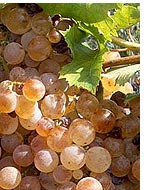 The
Castelli Romani due their name to the presence of at least a
noble mansion in each of them and even if some of these mansions
were destroyed during past historical events, their ruins are
still witnessing the feudal origin of this zone. The
Castelli Romani due their name to the presence of at least a
noble mansion in each of them and even if some of these mansions
were destroyed during past historical events, their ruins are
still witnessing the feudal origin of this zone.
Viticulture grew gradually in this area thanks to the periodical
distribution of pieces of land among war veterans (starting
from those who participated to the Lepanto’s battle and
arriving to the ex-servicemen of the First World War), who utilised
their modest estates to create a production for a private consume
and a more intense one for the local market.
Even if belonging to an ancient tradition, the cultivation of
vineyards in the Castelli Romani’s area, knew a great
development with the building growth in Rome, as it determined
a gradual destruction of the wine estates which once, during
the pontifical period, were within the city itself; these were
the so called ‘terreni casalini’; vineyards with
plants growing on ancient house ruins, very famous for the quality
of their production.
Castelli Romani’s agricultural production, that was already
well-known for its vegetables and fruits (broccolis of Albano,
peaches of Castel Gandolfo, cabbages and artichokes of Velletri)
began to focalize on wine-making, planting at an early stage
different types of vines with fruits both to produce wine and
to eat. Their importance has left a spur in the large pergola
along the Via Appia Nuova, in the place still named Uva di Roma.
Later on viticulture specialized basically in the production
of grapes for wine in specific vineyards.
The Castelli Romani’s vineyards go from the valley to
the slopes of the hills in that places where the mechanized
cultivation is still possible.
The vineyards situated on the slopes are surrounded by olive
groves, which create a silvery frame to them.
On the highest part of the hills, quite on the summit, there
are chestnut threes. These trees were planted from Popes, so
that people living here, which had not other type of vegetables,
could eat their fruits. The chestnut trees for the production
of fruits have been gradually substituted with chestnuts for
the production of wood.
The present varieties of vineyards resulted from a long and
tenacious work of a Commission, that at the end of the last
century, after that the phylloxera had attacked vines, established
what vines’ kinds had to be planted according to their
characteristics.
There were vineyards denominated according to the place and
cultivation methods. The most widespread vine was the “conocchia”,
i.e. 6 reeds sustaining the trailing branches of the plants,
departing from a central stem.
The local vineyards had different names: romano, pecorino, fil
di ferro, procanico, francese and so on.
The choice of white grapevines which were very widespread was
not casual, but the vines had been chosen so that they could
integrate the production of other vines to produce harmonic,
fresh and delicate wines. The Malvasia di Candia – probably
a vine’s type imported by soldiers which took part in
the Lepanto’s Battle commanded by Marcantonio Colonna
– is a prolific variety and the wine produced from it
has an aftertaste like the almonds, while the Malvasia nostrale,
del Lazio or puntinata, gives a strong bouquet to the wine but
it is not very prolific. The Trebbiano Toscano was chosen because
its abundant grapes are delicate and amalgamates the fragrances
of the other wines. The yellow Trebbiano, or Greco or Grechetto,
is not very prolific but very delicate and rich in aromas. The
wines produced from the green Trebbiano can be aged and have
the characteristic perfume of vines’ flowers. The Bellone
and the Cacchione produce a lot of must. The Bonvino or white
Bombino were planted as their grapes could be eaten and if used
in vinification gave to the wine a fine harmonic taste and a
full bodied fragrance.
These types of vines were reduced to only some vineyards according
to the environment and the producers. At present there are two
tendencies: recovering the original varieties, or planting new
varieties to improve the wine’s quality and to satisfy
the market needs.
Among the red grapevines there are: the Cesanese comune, producing
a loveable wine; the Merlot with its aroma and taste of fruits;
the Montepulciano, producing a full bodied wine; the Nero Buono
or Nero di Cori, a precious vine for the colour and the delicate
taste it gives to wine; the Sangiovese a very prolific kind,
producing a wine perfect to be aged and increasing the scented
smell and taste of fruits to the wine. In addition to all these
vineyards there is the Cerasuolo with its taste of cherry.
In addition to the DOC wines chosen according to the rules,
each producer sells on the market wines with the generic denomination
“DOC Castelli Romani”, that has been recently created,
and I.G.T. (Typical Geographical Designation) wines for lunchtime,
satisfying the different customers’ needs. These last
type of wines reaches an high quality level.
|

